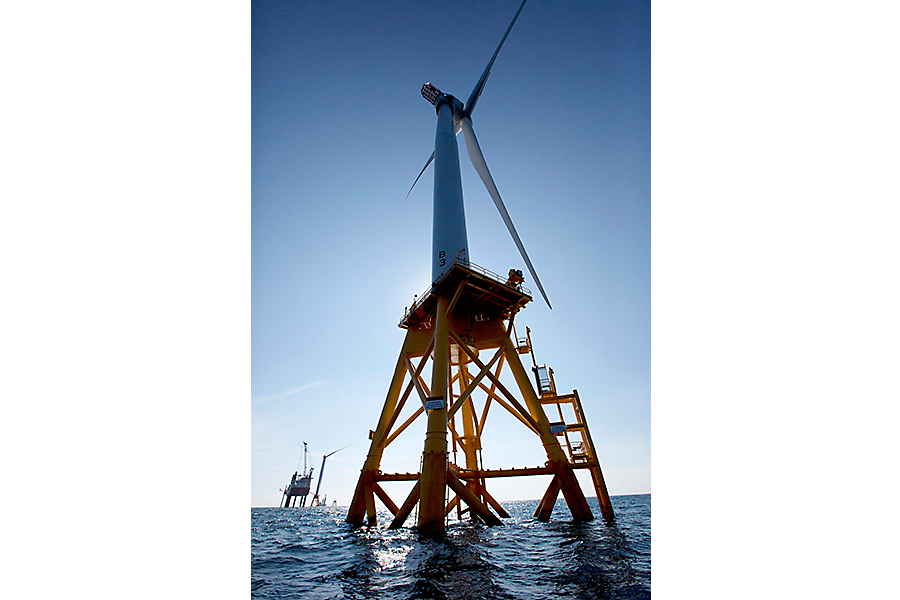Block Island wind farm opens: Will the breeze keep blowing for wind power?
Loading...
The nation’s first offshore wind farm has begun to provide power to Rhode Island in what developer Deepwater Wind, federal regulators, and industry experts hope is the first of many to dot US waters.
“We’re more confident than ever that this is just the start of a new US renewable energy industry that will put thousands of Americans to work and power communities up and down the East Coast for decades to come,” said Jeffrey Grybowski, the chief executive officer of Deepwater Wind, in a statement Monday.
The opening of the Block Island Wind Farm off the Rhode Island coast marks a major milestone for an industry that has been slow to get off the ground in the United States. Europe, in comparison, has built a multi-billion-dollar offshore wind industry over the past two decades.
But states and federal regulators in the US have been placing bets on offshore wind through legislation and strategic plans as a way to generate more renewable energy in the face of aging power plants shuttering across the country.
At its peak, the Block Island Wind Farm – built by union labor – can power at least 17,000 homes, producing 30 megawatts of power at peak capacity. Its first priority is the small community living on Block Island. Then, all excess electricity flows through a submarine transmission cable into New England’s power grid.
The five towering turbines, clearly visible from the Block Island coast, cost almost $300 million to build.
The farm is considered a pilot project, especially in comparison to Europe, where thousands of offshore turbines already produce energy and and where offshore wind farms with 300 turbines are in development, according to The New York Times.
In general, offshore wind farms are seen as more reliable than onshore ones. Strong, steady wind that blows day and night makes coastal waters ideal for wind energy production.
“But building offshore turbines brings with it greater challenges than building onshore ones,” wrote David Unger for The Christian Science Monitor in 2013. “Higher costs, harsh waters, concern for local ecosystems, and the desire to preserve scenic ocean views have kept the US offshore industry in relative infancy compared with onshore” and with Europe.
Then there’s the cost. In Europe, after decades of widespread use, a single turbine still costs up to $30 million to install and connect to the power grid, reports the Times.
But state and federal regulators see the power potential of offshore wind as offsetting its current costs. A national offshore wind industry could generate twice the nation's current electricity needs, according to a report the US Departments of Energy and the Interior released in September. That strategic plan calls for wind power to provide 20 percent of the nation’s electricity by 2030 – a dramatic increase from the 4.5 percent it currently provides.
New England states, with high energy demands and few power plants, have been early leaders in the call for offshore wind power. Massachusetts and New York recently passed laws requiring their energy grids to receive a significant amount of their energy from wind. Gov. Charlie Baker (R) of Massachusetts signed legislation over the summer that requires utilities to procure a combined 1,600 megawatts of electricity from offshore wind farms by June 2027.
The Department of the Interior’s Bureau of Ocean and Energy Management has also awarded 11 commercial offshore wind energy leases for sites in the Atlantic. Another lease sale is set for Thursday for the rights to develop a huge offshore wind farm between New York and New Jersey, although commercial fishing companies, trade groups, and seaport communities have asked a court to delay it, reports the Associated Press.
Developers have also requested commercial wind leases off the coasts of California and Hawaii.
While supporters point to the Block Island wind farm as just the first step toward a green energy future, the winds could turn under the Trump administration. President-elect Donald Trump has criticized wind farms, calling them ugly and getting into a protracted legal fight with the government of Scotland over offshore wind farms near a Trump-owned golf course, comparing them to a terrorist attack. He has also promised to tear up President Obama’s Clean Power Plan, a driver for offshore wind and other renewable energies.
This report contains material from the Associated Press.







